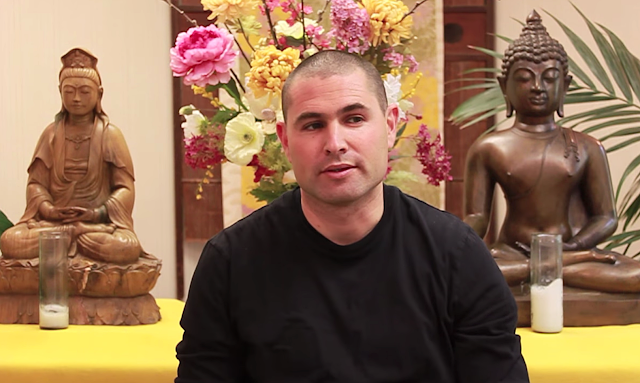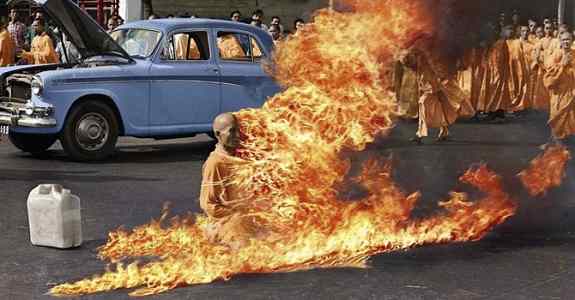Masculine Buddhism and Feminine Buddhism
Perhaps we must acknowledge the justness of the distinction which assigns to man the sphere of wisdom, and to woman that of love, though neither belongs exclusively to either. Man is continually saying to woman, Why will you not be more wise? Woman is continually saying to man, Why will you not be more loving? —Henry David Thoreau
Sometimes I think that the biggest difference between men and women is that more men need to seek out some terrible lurking thing in existence and hurl themselves upon it. Women know where it lives but they can let it alone. —Russell Hoban
I remember seeing long ago a quote, I think it may have been by the Bhagwan Shree Rajneesh, alias Osho, that goes, “The man takes by giving; the woman gives by taking.” I think there is some profundity in that. The Bhagwan was a rascal and perhaps a charismatic con artist, but he did have some genuine wisdom—though, as I say, I’m not sure the quote is his. One thing that I’m fairly confident he did say, if my memory serves me correctly, is that the spiritual battery of the human body, so to speak, has opposite polarities in men and women. A man has a positively charged groin and a negatively charged chest, and a woman is vice versa.
This is all politically incorrect to acknowledge lately, although it is of course still empirically true that men and women are naturally different, both physically and psychologically. We evolved to fit different niches within early human society, with women more adapted to bearing and raising children and engaging in peaceful foraging, and so on, and men more adapted to hunting and protecting the tribe from outward dangers. This has resulted in what is called sexual dimorphism in our species, with the differences being mental as much as physical.
Consequently, putting it very simply, male and female temperaments differ, on average, and this difference is largely conditioned by hormones, including prenatal hormones which produce lifelong effects. Thus men, on average, tend to be more aggressive, objective, and “head-oriented” than women, and women tend to be more insecure, subjective, and “heart-oriented” than men. Men identify more with their thoughts, women identify more with their feelings. This is how we have been for a million years or more, and to deny it for the sake of gender equality or social justice or whatever is just plain delusional.
Thus it should be no surprise that the spiritual paths favored by men and women also tend to differ to some degree. Men and women tend to approach Dharma differently (and by “Dharma” I simply mean spiritual cultivation, not necessarily Buddhism or Theravada Buddhism). A male approach to religion tends to be more philosophical and head-oriented than a female one. Another Dharma quote whose origin I don’t remember: A woman progresses from love to prayer, and a man progresses from prayer to love. In other words, women tend to start with the heart and develop the head, and men tend to be the other way round. We start from where we’re at, and then cultivate what we lack. Neither of these two approaches is necessarily better than the other; it's just the way we are. Then again, we tend to emphasize what we’re already good at. Sometimes that last quote isn’t quite accurate; men may stay objective and philosophical right up till the end is attained, and women may stay subjective and devotional. That last quote is evidently the expression of an ideal of spiritual balance that often is not realized. But that’s all right too: a head-oriented approach and a heart-oriented one are both equally valid, all else being equal.
It should be borne in mind, although in the west it usually isn’t, that Buddhism began as one of the most emphatically male-oriented spiritual systems on earth. In its own way it may be more “patriarchal” even than Islam throughout most of its history. Possibly the only spiritual system more male-oriented than early Buddhism, that I know of, would be the ancient militaristic religion of Mithraism, from which women allegedly were excluded altogether. Buddhism was originated by a man, primarily for men, and the system was further developed over the next many centuries almost entirely by men—and not just ordinary men but relatively tough forest ascetics and celibate philosophers who scrupulously avoided the company of women. (It is true that there was an Order of ordained Buddhist nuns, but according to the Pali texts they were allowed only late in the Buddha’s career as a teacher, and he thought it was a horrible idea anyway and allowed women’s ordination very reluctantly.) Theravada Buddhism especially has not been masculine in the sense of being militaristic or aggressively violent, except in very unorthodox and/or politically expedient quasi-Buddhist movements; but it has always been very philosophical and predominantly head-oriented, as opposed to devotional and heart-oriented, and emphasizes stereotypically masculine virtues such as asceticism, fearlessness, insistence on freedom rather than security, and unflinching determination.
Even so, stereotypically feminine virtues such as compassion and gentleness are certainly found even in the most ancient Buddhist teachings, and they have clearly been held in high esteem since the beginning. But even these stereotypically feminine qualities have tended to be filtered through a masculine, intellectual perspective. An example would be traditional mettā or “loving-kindness” meditation, as taught in the Pali texts, and which is emphasized rather a lot in some western versions of Theravada: a bhikkhu is instructed to direct mettā in all directions, toward all beings in the universe, in a very abstract manner, not through any deep interpersonal feelings between him and any other being in particular. There wasn’t supposed to be much interpersonal interaction and emotional “bonding” anyway for early Buddhist ascetic recluses; the only people they would meet on an average day might be the people who put food into their alms bowl in the morning, with whom a monk is discouraged from striking up any sort of intimacy. So even the more feminine qualities of early, canonical Buddhism had the head as a kind of intermediary between the heart of a monk and the outside world, including other conscious beings. The pronounced feminine/feminist attitudes of most western Buddhists nowadays is a modern (or postmodern) western mutation or emasculation of an ancient tradition, and not closely resembling what Buddhism has been for 2500 years in Asia.
Nevertheless, it can still be said that two main approaches to Dhamma have existed since the earliest times, one stereotypically more masculine, and the other more feminine. Both are well represented in the Pali texts. The two can be described in short as alternative emphases on thoughts and on feelings, “head” and “heart,” an emphasis on ending moha or delusion and an emphasis on ending dukkha or suffering.
One of the most central principles of early Buddhism, probably of Buddhism in general, is the four Noble Truths (ariya saccāni), with their usual formula emphasizing the cessation of dukkha as the primary purpose of Dhamma. In fact the Buddha is said to have said that suffering and the cessation of suffering constitute the whole of his message. But even so, this suffering and the desire and attachment which cause it are themselves based on delusion or ignorance; and thus the cessation of suffering depends on the cessation of the underlying lack of wisdom resulting in the desire. So again, even the more feminine, compassionate, feelings-oriented approach to Dhamma ultimately gets filtered through more masculine intellectuality and objective philosophy.
One may plausibly assert that the more feminine path is to strive for the end of suffering, and the more masculine is to strive for the end of delusion. The seeming dichotomy is reminiscent of other standard dichotomies such as philosophy/religion, intellect/faith, or scientific temperament/artistic temperament. In Hindu Yoga the distinctions may be more clear cut, for example with Jñāna Yoga as the philosophical, head-oriented path and Bhakti and Karma Yogas as being more devotional and compassionate. It’s all good, and the choice one makes is more a matter of personal temperament than anything else. There’s more than one way to proceed, so one may as well choose a path with which one resonates, with which one has a deep affinity. Ultimately they all lead to the same Enlightenment. Although of course in the feminized west, with an abundance of female teachers and a Starbucks socialist aversion for masculinity, the more traditional, more ancient, and more authentic masculine approach has become “marginalized” as masculinity itself has become viewed as straight-out toxic and the cause of all evil. Among certain western spiritual or quasi-spiritual circles, heart is good, head is bad. But that’s more politically correct cultural Marxism and misandrist feminism than genuine Dhamma or Dharma.
The very fact that the new left in the west denies any fundamental difference between men and women is itself a form of delusion, arguably a symptom of abandoning masculine objectivity and insisting upon feminine subjective feelings as the criterion for determining reality. Nevertheless, despite all the mass hysteria, men and women differ not only physically and emotionally, but also to some degree spiritually. And a wise, more or less masculine acceptance of this fact is much more conducive to the cultivation of wisdom than is Social Justice-oriented denial of plain facts. A great difficulty for western Buddhism, if not an insurmountable obstacle, is that it has been commandeered by cultural Marxism, intersectional feminism, etc. which have been mutating Dharma into something radically different from what the Buddha taught, or ever intended. You like a more heart-oriented approach to Liberation? Fine. But dismissing or even demonizing the more traditionally Buddhist objective, ascetic approach on behalf of liberal, secular western civilization in general is ultimately going to make more problems than it solves.








On the "more or less androgynous western Dharma teacher" is there actually anything in the monastic code that demands a monk be completely clean shaven? Can a monk get by with retaining at least some stubble of a beard? And what's with the soft speech pattern? Don't they realize that Buddha could not have spoken like that, you know speaking to people in the outdoor world where even chirping birds would drown out these guys' soft girly speeches?
ReplyDeleteAccording to the rules of monastic discipline, a monk is required to shave his head and face before the stubble is two finger widths in length, or within two months, whichever comes first. This was largely a symbolic act of cutting off one's social status, considering that men in ancient northern India usually wore long hair and beards. If the Buddha were alive today in the west he might have his monks grow beards and long hair as a symbolic way of dropping out of society.
Delete"even chirping birds would drown out these guys' soft girly speeches" 😂
DeleteHmm... Threatening Dhamma would be needed, because Samsara is a bitch 🚺that holds these politically correct buddhists tight, lures them to conformity with sweet sweet promises.
What comes to women... I don't really like that head/heart dichotomy... I don't know exactly why... I also detest the level of mysticism that surrounds the whole idea of prayer and heart. Already in Guénon's time there were these orthodox, catholic and muslim circles that flocked around Traditionalism and they just thought the Middle Ages was the epitomy of Traditionalism and they saw no danger whatsoever in traditional semitism. They focused on bhakti, service, prayer, paradise, (metaphysical) love and obviously theism.
All that leads to very semitic vision of life - something that I like to think is very distant from Solar clarity of buddhism.
Here is an example of the Semitic Traditionalism, which is really just the mainstream Traditionalism unfortunately: https://youtu.be/OkbOGNzR99s
Samuli, seems to me that a desire for eternal life is based upon a rather timid fear of death. Buddhism seeks liberation FROM eternal life. It really would be nice if the Jehovah's Witnesses are correct, because they don't believe in Hell, and thus we who are not worthy of Paradise are simply poofed out of existence; and I consider that to be preferable to the JW paradise of eternal fruit picking, picnics, and hugging large wild animals.
DeleteYes, on one level it's the fear of death, but even elsewhere it's always some kind of sublimation and stemming from the most obscure sources: prophets, messiahs and saviors.
DeleteIt's just impossible to take seriously so blatant attempts to justify their superstitions and sensuality by "transcending" it to "metaphysical love", Virgin Mary, and any other "high-minded" concept the horny desert dwellers used to justify their belly dance entertainment. Some of those moronic Traditionalists think that the West degenerated dancing by introducing pair dances! In reality "traditional" islamic dances and modern striptease are on the same vein, the latter just a more extreme conclusion of the former. It's no accident that precisely Islam is growing GLOBALLY, because it fits the logical continuum of triumphal Semitism.
The problem with some traditionalists when they say that "labels are not important" (i.e. whether you're a muslim or a buddhist) or that "metaphysical truths of true traditions are the same" is that they just ignore the power (even magic) of these suggestions that are already contained in the subject matters, sometimes even in words!
For example: why would one even think of "a paradise" or "a hell" (buddhism also had hells although Evola argued they were foreign influences)?
Or God and theism?
It doesn't matter what form that theism takes, even if it's "Solar theism", it's still an inferior point of departure and certainly of arrival.
If there's one thing that Richard Dawkins coined well it's the concept of meme. Understanding Semitic Traditionalism is facilitated by that concept. Semitic memes spreading and seeking new hosts.
I just recently dodged contamination after researching the Bible and some NatSoc Christians... It's dangerous at every level, from the surface where ideas first appear through contact to the very core where they are represented in "esoteric christianity" and the like.
Samuli, your idea as expressed seems muddled.
DeleteAnd I thought Serrano's ideas were seemed muddled!
Deletehttps://youtu.be/S3S3ah_o-Tg
Hey Man. I hear you on all of this. I prefer a buddha with balls who challenges me to be more than I am rather than one that lets me off the hook. Trust me, I need the challenge. However, from the historical perspective, how do you fit in Kuan Yin? I prefer your take on Buddhist compassion being more appropriately related to Avolokitishvara (and therefore at least to me, intellectual like in the fact that it was he who shared the Heart Sutra with us which is hardly a mushy and feely sutra). But Kuan Yin seems to have changed from male to female (at least in China) a long time ago - like 800 years maybe? I've heard that she is really an import of the Virgin Mary into Buddhism, which in light of your essay here makes a certain amount of sense. THat is to say her thought-form or however you choose to visualize Buddhist anthropomorphic entities - is not native to Buddhism but rather an import from the West.
ReplyDelete